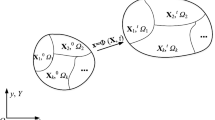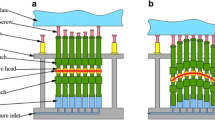Abstract
This study aims to develop a universal, robust, and linear method to obtain an initial guess configuration for the multi-step finite element method (FEM) solver of sheet metal forming. Using the decoupling theory, the deformation at each step in the multi-step FEM solver of the sheet metal forming is decoupled into two independent deformation modes: bending-dominated deformation and stretching-dominated deformation. The configuration of the bending-dominated deformation constrained by the sliding constraint surface is considered as the initial guess configuration for the current step in multi-step FEM solver. To get an accurate initial configuration at each step, the method of Laplace-Beltrami operator (LBO) on a simplicial surface is employed to obtain the initial guess configuration effectively. Several numerical examples are provided for validation and verification of the proposed method through its applications for complicated sheet metal workpieces of finite element simulations. The results show that the proposed method on the simplicial surface for the initial guess configuration within a few iterations to be significantly effective.





















Similar content being viewed by others
References
Majlessisa LD (1987) Further development of sheet metal forming analysis method. J Eng Ind 109:330–337
Wang J, Goel A, Yang F, Gau JT (2009) Blank optimization for sheet metal forming using multi-step finite element simulations. Int J Adv Manuf Technol 40:709–720
Ablat MA, Qattawi A (2017) Numerical simulation of sheet metal forming: a review. Int J Adv Manuf Technol 89:1235–1250
Liu WJ, Zhang XK, Hu P (2017) Developments of multi-step simulations in sheet metal forming processes. Int J Adv Manuf Technol 93:1–19
Bathe KJ (2006) Finite element procedures. Prentice Hall
Kim SH, Huh H (2002) Construction of sliding constraint surfaces and initial guess shapes for intermediate steps in multi-step finite element inverse analysis. 130-131:482–489
Wu JJ, Zhu H (2008) Study on the double spreading plane based mapping method and its application in the fast simulation of multi-steps stamping. J Plast Eng 15:152–154
Levy B, Petitjean S, Ray N, Maillot J (2002) Least squares conformal maps for automatic texture atlas generation. ACM Trans Graph 21:362–371
Liu Q, Xi J, Wu Z (2013) An initial solution estimation method based on as-rigid-as-possible mesh parameterization for one-step simulation. Eng Comput 30:379–398
Bao YD, Cui J, Lin ZX, Chen WL (2015) Trimming line development method of auto panel part with undercutting flange. Finite Elem Anal Des 2015(102-103):29–36
Liu WJ, Hu P, Zhou P, Zhang XK (2012) Research on intermediate configurations of multi-step inverse approach in sheet metal forming. J Mech Eng 04:25–29
Lan J (2001) Research on inverse finite element approach for sheet metal forming. Huazhong University of Science and Technology [in Chinese]
Fu LJ, Dong XH, Peng F, Wang P A generally suited method to get initial guess solutions for one-step and multi-step simulations of tube and profile forming based on parameterization. Int J Numer Methods Biomed Eng 27:1622–1639
Huang Y, Chen YP, Du RX A new approach to solve key issues in multi-step inverse finite-element method in sheet metal stamping. Int J Mech Sci 48:591–600
Na JX, Chen W (2013) One step positive approach for sheet metal forming simulation based on quasi-conjugate-gradient method. Chin J Mech Eng 26:731–737
Chen W, Na JX (2016) The multi-step positive approach for sheet metal forming simulation based on the quasi-deformation theory. Eng Mech 33:236–242
Chen W (2013) Research on fast sheet metal forming simulation approach. Jilin university [in Chinese]
Tabarrok B, Qin Z (1992) Nonlinear analysis of tension structures. Comput Struct 45:973–984
Bunting CF (2008) Introduction to the finite element method. Electromagnetic Compatibility. IEEE International Symposium on IEEE
Kubli W, Reissner J (1995) Optimization of sheet-metal forming processes using the special-purpose program AUTOFORM. J Mater Process Technol 50:292–305
Aflalo Y, Kimmel R, Zibulevsky M (2013) Conformal mapping with as uniform as possible conformal factor. SIAM J Imaging Sci 6:78–101
Xu G (2004) Discrete Laplace–Beltrami operators and their convergence. Comput Aided Geom Des 21:767–784
Fisher M, Schröder P, Desbrun M, Hoppe H (2007) Design of tangent vector fields. ACM Trans Graph 26:56–64
Du Q, Gunzburger FM (1999) Centroidal voronoi tessellations: applications and algorithm. SIAM Rev 41:637–676
Polthier K (2002) Computational aspects of discrete minimal surfaces. Glob Theory Minim Surf:65–111
Meyer M, Desbrun M, Schröder P, Barr A (2002) Discrete differential-geometry operators for triangulated 2-manifolds. Math Visual 6:35–57
Crane K, Wardetzky M (2017) A glimpse into discrete differential geometry. Not Am Math Soc 64:1153–1159
Wardetzky M, Mathur S, Kalberer F, Grinspun E (2007) Discrete laplace operators: no free lunch. Eurographics Symposium on Geometry Processing, Barcelona, Spain, July. DBLP:33-37
Liu YC, Bao YD, Hu QW, Chen WL (2019) Improved contact searching algorithm of large step implicit FEMs. J South China Univ Technol 47:136–144
Kawai T, Yoshimura N (1969) Analysis of large deflection of plates by the finite element method. Int J Numer Methods Eng 1:123–133
Zhu BF (2018) The finite element method theory and applications. China Water & Power Press
Botsch M, Sorkine O (2008) On linear variational surface deformation methods. IEEE Trans Vis Comput Graph 14:213–230
Shewchuk JR (1994) An introduction to the conjugate gradient method without the agonizing pain. Carnegie Mellon University
Randolph E, Dupont T, Yserentant H (1988) The hierarchical basis multigrid method. Numer Math 52:427–458
Botsch M, Bommes D, Kobbelt L (2005) Efficient linear system solvers for mesh processing. Lect Notes Comput Sci 3604:62–83
Emilie H, John E, Ravi V (2008) Development of forming limit diagrams of aluminum and magnesium sheet alloys at elevated temperatures. J Mater Eng Perform 17:288–296
Keeler SP, Backofen WA (1963) Plastic instability and fracture in sheets stretched over rigid punches. Transp Q 56:25–48
Funding
This work was partially funded by the open fund project of key laboratory of precision and micro-manufacturing technology in Jiangsu province. The authors also would like to show their gratitude to the financial support from the project of the introduction plan of high-leveled experts in 2019 by Nanjing University of Aeronautics and Astronautics (No.G20190010161).
Author information
Authors and Affiliations
Corresponding author
Additional information
Publisher’s note
Springer Nature remains neutral with regard to jurisdictional claims in published maps and institutional affiliations.
Rights and permissions
About this article
Cite this article
Liu, Y., Chen, W., Hu, Q. et al. A new method to get initial guess configuration for multi-step sheet metal forming simulations. Int J Adv Manuf Technol 110, 2651–2668 (2020). https://doi.org/10.1007/s00170-020-05907-5
Received:
Accepted:
Published:
Issue Date:
DOI: https://doi.org/10.1007/s00170-020-05907-5




